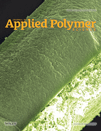Micellization behavior of ionic liquid surfactants with two hydrophobic tail chains in aqueous solution
Abstract
The drop volume method was used to determine the surface tensions of two series of polymerizable ionic liquid surfactants, namely, 1-acryloyloxypropyl-3-alkylimidazolium chloride [APCnim][Cl] (n = 8, 10, 12) containing two hydrophobic tail chains and 1-propionyloxypropyl-3-alkylimidazolium chloride [PPCnim][Cl] (n = 8, 10, 12), which showed similar structures with [APCnim][Cl] (n = 8, 10, 12) at 25°C. The surface properties of the surfactants were also compared. Furthermore, the thermodynamic behavior of [PPCnim][Cl] (n = 10, 12, 14) micellization in aqueous solution and the enthalpy–entropy compensation phenomenon were studied. The two kinds of surfactants had high surface activity. Double bonds had almost no effect on the surface properties of [APCnim][Cl]. The micellization of [PPCnim][Cl] in aqueous solution was spontaneous and entropy-driven. For the surfactant with specific structure, micellization ability initially increased and then decreased with temperature increase. The entropic contribution to Gibbs free energy change tended to decrease, whereas the enthalpic contribution increased. In addition, the enthalpy–entropy compensation phenomenon occurred during the micellization process. For all [PPCnim][Cl], the compensation temperature was (314 ± 1) K, which remained unaffected by the surfactant molecular structure. However, when the hydrophobic carbon chain length increased, both micelle formation ability and stability increased. © 2013 Wiley Periodicals, Inc. J. Appl. Polym. Sci., 2013




